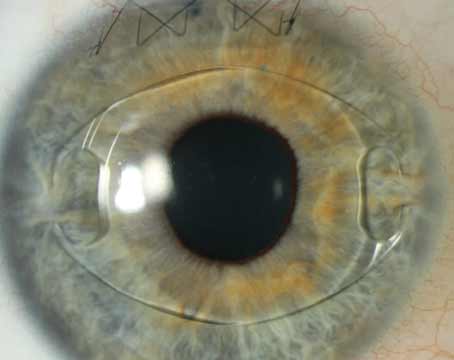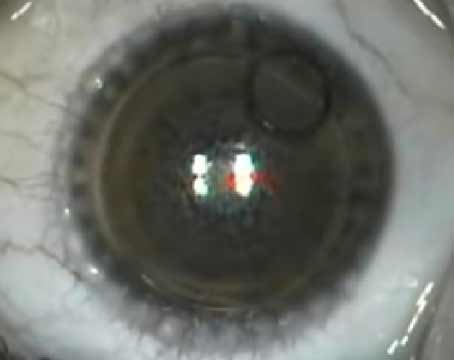CONTACT LENS PROFESSIONALS PLAY AN IMPORTANT ROLE in ophthalmic patient care. The technician is often the first to notice a change in refractive state or witness inflammatory processes.
Corneal infiltrates with staining (possible ulcer) always require medical attention. Detecting irregular corneal topographies and identifying keratoconus is particularly important in screening potential refractive surgery candidates.
Keratoconus is a non-inflammatory, progressive corneal ectasia with associated mixed irregular myopic astigmatism. Its prevalence ranges from 50 to 230 per 100,000 individuals. It is found in all races. It usually manifests during puberty and progresses during the patient's 30s and 40s. The rate of progression slows and often stops during the fourth and fifth decades of life. It is unusual for keratoconus to initially appear after age 50.
Some of the signs and symptoms associated with keratoconus include:
• decrease in best corrected visual acuity; inability to correct to 20/20;
• Rx changes in cylinder power and axis;
• progressive myopia;
• squinting/squeezing to see; and
• complaints of shadows or ghost images.
One of the first clues that something is amiss may be a patient's change in refraction. It is common to see incremental increases in the spherical (myopic) component of the prescription during adolescence and early adulthood. It is not normal to see a change in the cylindrical component of the refraction. With few exceptions, the amount and axis of a person's astigmatism should not change from year-to-year.
The following example illustrates a prescription change that may be a cause for concern:
Last year's spectacle lens prescription: OD: -3.00 + 1.00 X 90°; this year's spectacle lens prescription: OD: -4.74 +2.75 X 60°.
This change in both the amount and the axis of astigmatic correction should be cause to look further. A slight change in the amount of cylindrical correction, ± 0.50 D, is acceptable. Diopteric changes over 1 D should be suspect. On the other hand, change in a patient's astigmatic axis, ± 20°, is very unusual and requires further investigation.
In keratoconus, the axis of astigmatism, as measured by the keratometer or corneal topographer, usually starts out as normal with-the-rule (plus power at/near 90°) astigmatism and moves toward the oblique (45° or 135°) as the condition advances. Further investigation involves measuring the cornea's curvature. Figures 1A and 1B show change from normal to suspect topography. Figure 2 represents early to moderate keratoconus. It should be noted that the upper half of the cornea appears normal. This is expected since keratoconic changes usually affect the inferior portion of the cornea first.
 |
 |
| Figure 1A. Normal topography image of the corneal. | Figure 1B. Change from normal to suspect topography. |
 |
 |
| Figure 2. Moderate keratoconus. | Figure 3. PMD corneal ectasia. |
To make the diagnosis of keratoconus, the ophthalmologist will examine the cornea for stromal scarring, thinning, Fleisher (iron pigment) ring and Vogt's striae (vertical stress lines at the level of Descemet's membrane).
Another form of corneal ectasia, pellucid marginal degeneration (PMD), may be differentiated from keratoconus by its axis of astigmatism. As stated earlier, the primary axis in keratoconus starts out with-the-rule and moves toward an oblique axis. The primary axis in pellucid marginal degeneration is against-the-rule (plus power at/near 180°).
Additionally, the slit lamp picture of PMD shows marked corneal stromal thinning close to the inferior limbus. In keratoconus the apex of the cone and the corneal thinning is usually more centrally located.
Corneal ectasias can also be created by contact lenses. Both rigid and soft contact lenses can potentially alter the cornea's shape. An ill-fitted contact lens can mold the cornea and mimic irregular topographies like keratoconus. One can intuitively appreciate how rigid lenses can mold and reshape the cornea. It is a little less obvious how soft lenses can mold the cornea.
The soft lens categories more likely to cause molding are stiff (high modulus) materials, thick low water lenses (may cause hypoxia), lenses worn on a continuous basis and lenses fitted excessively steep.
Contact lens-induced corneal molding is usually associated with loss of best-corrected visual acuity. The good news is that most corneas return to normal and regain their previous level of best corrected vision after discontinuing lens wear.
Refractive changes and corneal topography irregularities can indicate a cornea's ill-health. Ocular redness can also suggest corneal involvement. Ocular inflammations can be infectious, non-infectious, insignificant or sight threatening. However, ocular injection alone does not indicate what the cause might be. Redness is a non-specific response that only indicates something is irritating the eye. Among contact wearers, this may due to environmental drying, solution reaction or a tight lens or may be as serious as an infectious keratitis.
Changes in spectacle refraction cylinder and axis components, best corrected vision, irregular keratometry and/or irregular topography maps, and injection, require investigation to determine the significance and cause. Many of these signs of change can be detected during routine evaluation by the contact lens fitter and should be presented to the associated ophthalmologist for thorough examination.
Mr. Ward is the director,of the Contact Lens Service and an instructor in Ophthalmology at the Emory University School of Medicine. Contact him at mward@emory.edu.






